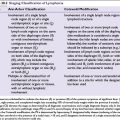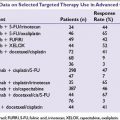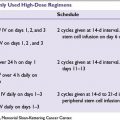In the Z9001, approximately 50% of patients with tumors >10 cm had recurrences in the first 3 years. This finding prompted a European study randomizing patients with high-risk of recurrence to 12 versus 36 months of adjuvant imatinib. The 5-year RFS was 65.6% in the 3-year arm compared to 47.9% in the 1-year arm (P < 0.0001). OS at 5 years was 92.0% and 81.7% in the 3-year and 1-year arms respectively (P = 0.02).
Neoadjuvant Therapy
RTOG 0132/ACRIN 6665, a prospective phase 2 study, evaluated safety and efficacy of neoadjuvant imatinib mesylate (600 mg per day) for patients with primary GIST or the preoperative use of imatinib mesylate in patients with operable metastatic GIST. The trial continued post-op imatinib mesylate for 2 years. Early results among 63 patients, of whom 52 were analyzable, 30 patients with primary GIST (group A) and 22 with recurrent metastatic GIST (group B) showed response (RECIST) as follows: group A, 7% partial, 83% stable, 10% unknown; group B, 4.5% partial, 91% stable, 4.5% progression. Two-year PFS was 83% for group A and 77% for group B. Estimated OS was 93% for group A and 91% for group B. Complications of surgery and imatinib mesylate toxicity were minimal. This trial represents the first prospective report of pre-op imatinib mesylate in GIST. This approach is feasible, requires multidisciplinary consultations, and is not associated with notable postoperative complications.
Therapy for Unresectable Disease
Prior to the development of targeted therapy, the treatment options for metastatic GIST were extremely limited. GIST does not respond to conventional cytotoxic agents, with reported response rates to doxorubicin lower than 5%. Other commonly used chemotherapeutic agents yielded similarly poor responses in GIST. Kinase inhibitors have dramatically increased survival in GIST, with the median survival approaching 5 years.
Imatinib
Imatinib has been proven to be highly effective against GIST and has improved survival in metastatic GIST. Early results from clinical trials confirm the high activity of this novel treatment, with response rates of approximately 60% and arrest of tumor progression seen in more than 80% of patients, which results in fast relief of symptoms.
Imatinib is approved at a dose of 400 to 600 mg daily for GIST. Investigators have attempted to determine the most effective dose of imatinib in GIST patients. Two large international randomized phase 3 trials compared the efficacy of two different doses of imatinib in GIST patients. The studies were designed similarly to be combined in a meta-analysis (MetaGIST). Patients were randomized to receive either 400 mg of imatinib once daily (with crossover to 800 mg per day with disease progression) or 400 mg twice daily (for a daily dose of 800 mg). Response rates (mostly partial response or stable disease) were similar between doses in both trials. In the individual trials and the meta-analysis, PFS was prolonged with the 800 mg dose, but OS was not different between dosages.
Among KIT mutations, 70% are found on exon 11, 10% on exon 9; exons 13 and 17 are rarely involved. In a subgroup analysis of the MetaGIST analysis, the higher dose of imatinib was associated with better PFS for patients with KIT exon 9 mutations, but again, the higher dose was not associated with improved OS. In addition, approximately 80% of patients eventually develop secondary mutations in KIT exons resulting in progressive disease. Therefore, the current recommendations are to initiate therapy at 400 mg daily, and to increase to 800 mg daily for nonresponders.
Treatment with imatinib is generally well tolerated, although most common toxicities include grade 1 or 2 adverse events—most commonly nausea, diarrhea, periorbital edema, muscle cramps, fatigue, headache, and dermatitis.
Sunitinib
Sunitinib malate is an oral multitargeted tyrosine kinase inhibitor with antitumor and antiangiogenic activities. Sunitinib is approved for the treatment of patients with GIST after disease progression or intolerance to imatinib mesylate therapy. A double-blind placebo-controlled, multicenter, randomized phase 3 trial confirmed the efficacy and safety of sunitinib as second-line therapy in 312 patients with GIST showing disease progression or intolerance under imatinib mesylate therapy. Patients were randomized in a 2:1 ratio to receive sunitinib 50 mg daily for 4 weeks, with 2 weeks off (n = 207) or placebo (n = 105). Objective response rates in the sunitinib arm and in the placebo arm were 8% and 0%, respectively. Median time to progression was significantly longer in the sunitinib arm (6.3 vs. 1.5 months). Fifty-nine patients in the placebo group crossed over to sunitinib therapy due to disease progression. Ten percent had subsequent partial responses, suggesting that the optimal therapeutic effect of sunitinib may be observed when it is administered in the early disease phase. Hypertension and asthenia are the most common side effects with sunitinib.
Regorafenib
Regorafenib, a novel multikinase inhibitor that targets several protein kinases involved in tumor angiogenesis (VEGFR1–3 and TEK), oncogenesis (KIT, RET, RAF1, BRAF, and BRAFV600E), and the tumor micro environment (PDGFR and FGFR), was tested in a randomized phase III trial for patients with metastatic GIST who had progressed on imatinib and sunitinib. Median PFS was 4.8 months for regorafenib and 0.9 months for placebo (HR 0.27; 95% CI 0.19 to 0.39; P < 0.0001). OS was not significantly improved with regorafenib; however, crossover was allowed on the study. Common adverse events were hypertension, hand–foot skin reaction, and diarrhea.
Radiotherapy
The effectiveness of radiation therapy in treating GIST also has not been proven, and is typically reserved in rare circumstances for palliation of symptoms.
SMALL BOWEL ADENOCARCINOMA
Despite the fact the small intestine comprises over 90% of the intestinal surface area, small bowel adenocarcinoma (SBA) is actually a rare entity, accounting for <2% of all GI tumors. SBA accounts for approximately one-third of small bowel malignancies with the remaining histologies being neuroendocrine cancers (carcinoid), lymphoma, and GIST. The rarity of SBAs has limited research into the natural history, prognosis, and management of patients with this disease. Recent studies suggest SBA is more closely related to colorectal carcinoma than gastroesophageal cancers. Given the lack of clinical trial data to support treatment recommendations, SBAs are often managed similarly to colorectal cancers.
Epidemiology
Approximately 6,110 new cases of SBA and 1,100 deaths from the disease are reported annually in the United States. The incidence of adenocarcinoma is estimated to be 5.7 to 7.3 per million in the United States. Some studies have suggested the incidence of SBA is increasing, particularly in the duodenal region, which may be explained by the increased use of upper endoscopies. Although SBAs are only one-fiftieth as common as large bowel adenocarcinomas, they share a similar geographic distribution, with predominance in Western countries. In addition, they tend to co-occur in the same individuals, with an increased risk of SBA in survivors of colorectal cancer and vice versa.
Risk Factors
Genetic Predisposition
■Familial adenomatous polyposis: Patients with this condition develop multiple adenomas throughout the small bowel and colon, which may lead to adenocarcinomas. After the colon, the duodenum is the most common site of adenocarcinoma. A 1993 study from Johns Hopkins by Offerhaus et al. found that patients with familial adenomatous polyposis have a relative risk of more than 300 for duodenal adenocarcinoma but no elevated risk of gastric or nonduodenal small bowel cancer.
■Hereditary nonpolyposis colorectal cancer: Aside from colorectal carcinoma, patients with this genetic syndrome also develop endometrial, gastric, small bowel, upper urinary tract, and ovarian carcinomas. The lifetime risk of SBA in patients with hereditary nonpolyposis colorectal cancer is 1% to 4%, which is more than 100 times the risk in the general population. SBAs in persons with hereditary nonpolyposis colorectal cancer are distributed evenly throughout the small bowel. They occur at younger age and appear to have a better prognosis than sporadic small bowel cancers.
Predisposing Medical Conditions
■Crohn’s disease: The relative risk of SBA is estimated to be between 15 and more than 100 in patients with Crohn’s disease. Unlike most SBAs, Crohn-related tumors generally occur in the ileum, reflecting the distribution of Crohn’s disease. The risk of adenocarcinoma does not begin until at least 10 years after the onset of Crohn’s disease, and the adenocarcinoma typically occurs more than 20 years afterward.
■Celiac disease (nontropical sprue): Patients with celiac disease appear to be at increased risk of small bowel lymphoma and adenocarcinoma. A 2001 survey of adult celiac disease patients in the United States performed by Green et al. found a relative risk of 300 for the development of lymphoma and 67 for the development of adenocarcinoma. SBAs associated with celiac disease appear to have an increased incidence of defective DNA mismatch repair compared with those not associated with celiac disease, and are associated with an earlier stage at diagnosis and a better prognosis.
■Peutz-Jeghers syndrome: Hemminki has reported an approximately 18-fold increase in the incidence compared to that in the general population.
Pathology
Approximately 50% of SBAs arise in the duodenum, 30% in the jejunum, and 20% in the ileum. Similar to adenocarcinomas in the colon, those in the small bowel arise from premalignant adenomas. This occurs both sporadically and in the context of familial adenomatous polyposis.
Genetic analyses of sporadic SBAs suggest similarities and differences from the pathogenesis from colorectal carcinomas. Although K-ras mutation and p53 overexpression appear to be as common in SBA as in colorectal carcinoma, mutation of the APC tumor suppressor gene, which is characteristic of colorectal carcinoma, does not commonly occur in SBA. The SMAD4/DPC4 gene, which is often mutated in pancreatic and colorectal carcinomas, also appears to be inactivated in SBAs.
Most SBAs are solitary, sessile lesions, often appearing in association with adenomas. They are usually moderately well differentiated and are almost always positive for acid mucin. SBAs can be positive for carcinoembryonic antigen (CEA), carbohydrate antigen 19-9 (CA 19-9), and p53. Expression of c-erbB-2, Ki-67, and tenascin has also been described. SBAs arising from the ileum may show staining with neuroendocrine markers.
Clinical Presentation
The clinical presentation of SBA depends on the location of the primary tumor, its growth pattern, and the extent of metastatic spread. In general, symptoms are initially nonspecific and include anemia, bleeding, abdominal pain, nausea, and vomiting, or obstruction and/or perforation in cases of locally advanced tumors. Because of a vague presentation of SBA, the time between initial development of symptoms and diagnosis is often relatively long, approximately 6 to 8 months, and contributes to the higher percentage of advanced cases at the time of diagnosis (in contrast to colorectal cancer). Common sites of metastases include locoregional lymph nodes, liver, lung, and the peritoneum.
Diagnosis
Stay updated, free articles. Join our Telegram channel

Full access? Get Clinical Tree






